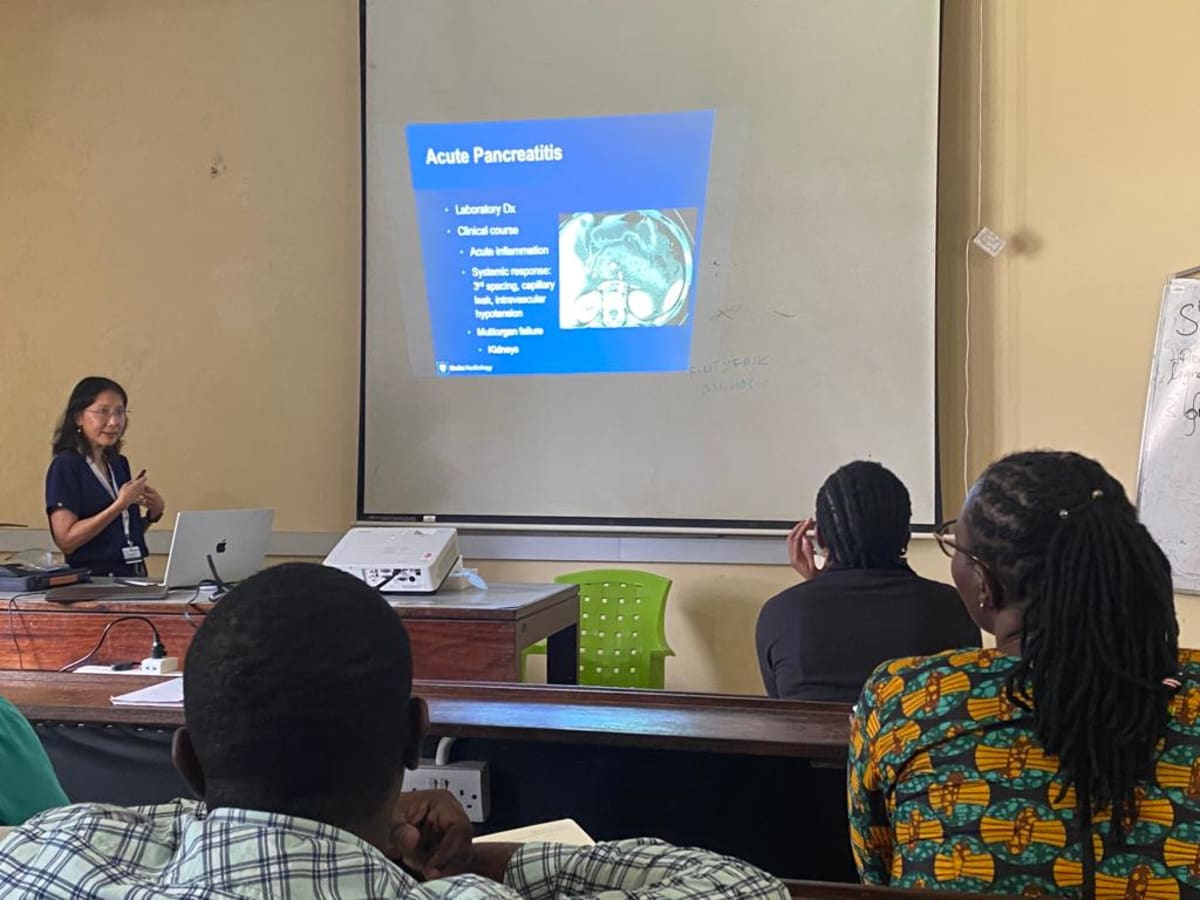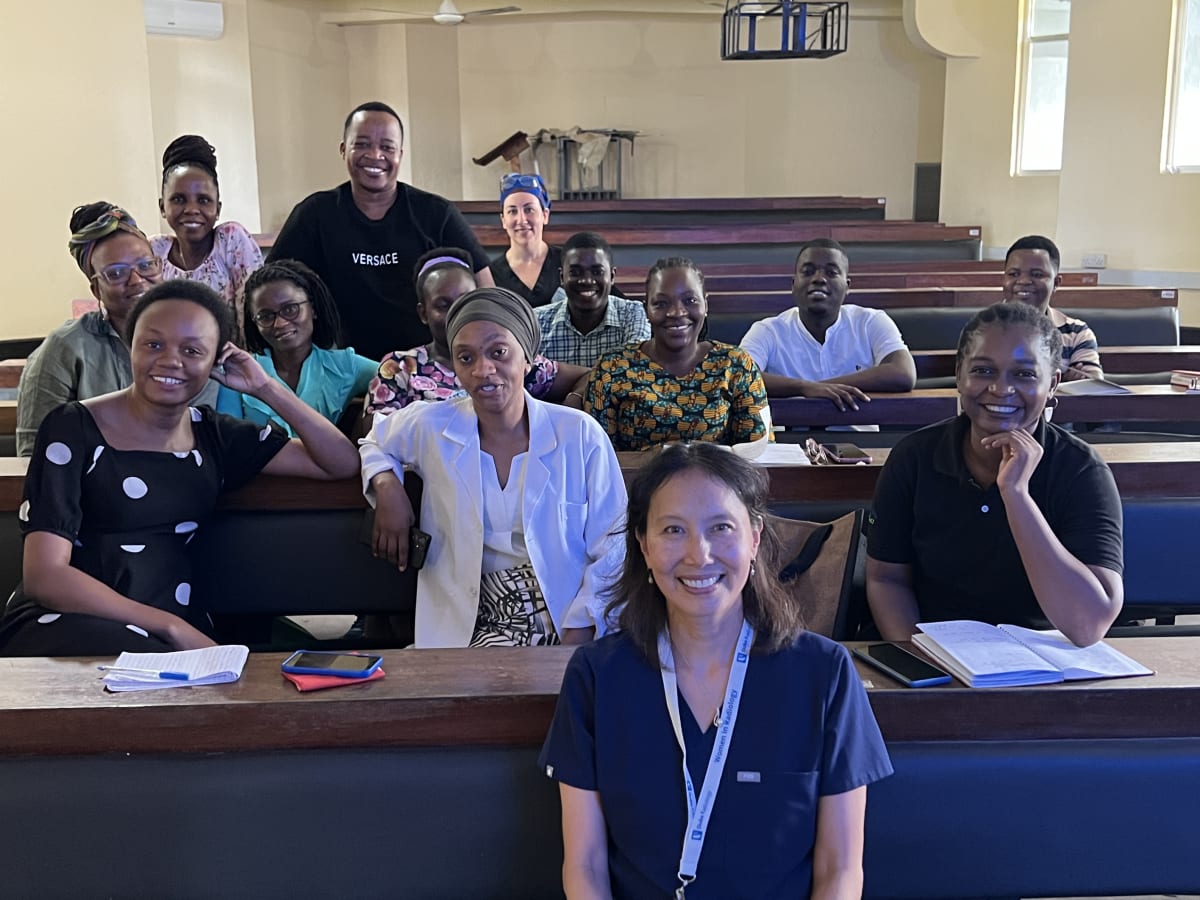Interventional radiology (IR) encompasses a unique but critical sphere of medicine that revolutionized the treatment of many medical conditions. Over the past 5 years, Road2IR has initiated East Africa's first IR training program, training the first generation of interventional radiologists in the country. Hands-on side-by-side procedural training is the key to developing confident, competent, and successful interventional radiologists.
As an academic diagnostic and interventional abdominal radiologist at Duke University with over 20 years of experience with trainee education, I plan to teach the diagnostic and interventional radiology residents at Muhimbili National Hospital in Tanzania.
This will be my second year at Muhimbili National Hospital. This year I will give lectures on imaging of the urinary system, liver, and acute abdomen and supervise image-guided biopsies and abscess drainages.
Based on my prior experience last year with supervising residents during image-guided procedures, I better understand what equipment is in short supply. I was astounded by the efficiency and resourcefulness of the residents who have so little essential equipment and supplies and so many patients in need of critical life-saving procedures. It also made me acutely aware of the abundance we take for granted and the amount of waste that physicians in the United States practice every day. As a result, for the past year, I have routinely asked our support staff to remove items from new sterile prepackaged trays that would be unused and otherwise wasted and save them to take with me back to Tanzania. I will also bring two boxes of new biopsy needles and drainage catheters.
While this program most immediately serves the 60 million people living in Tanzania, training IR physicians locally will have a regional impact. One of the first IR residents who graduated with the first class in 2021 in Tanzania is from Rwanda and has returned there as the first IR physician in the country. He has already begun the process of expanding these efforts there and plans to begin training the first generation of Rwandan IR trainees in late 2022. One of the prospective 2022 graduates in Tanzania is from Nigeria and will return there after completion of her training and start her own program in Nigeria. As such, our goal is to eventually serve the entire population of sub-Saharan Africa.
IR training of faculty and residents will directly impact and improve patient care by increasing access to life-saving or life-changing interventional procedures and therapies. These techniques are best taught by direct hands-on demonstration and supervision. Once these trainees have learned these skills, they can in turn teach them to future generations of radiologists in Tanzania.






This experience was my second year as part of the Road2IR interventional radiology team at Muhimbili National Hospital in Tanzania. This year, I planned to continue teaching the diagnostic and interventional radiology residents with both didactic lectures and supervision of image-guided procedures. I also brought a large bag of much-needed biopsy supplies which included core needle biopsy kits, sterile ultrasound probe covers, sterile ultrasound gel, tract dilators, and guidewires.
This year my work was predominately daily didactic lectures to the diagnostic radiology residents. The Tanzania diagnostic radiology residents are bright and eager learners and they place high value on up-to-date practice guidelines and educational materials. In all, I gave eight lectures which were approximately 1 hour each. My topics included: Imaging of Acute GI bleeding, Imaging of the Adrenals—what to do with the challenging adrenal nodule?, Liver lesion work-up part I: benign tumors and non-neoplastic conditions; Liver lesion work-up part II: malignant tumors; MRI of the Ovaries—what is O-RADS MRI?; Spleen imaging and intervention; Imaging of the Pancreas: anatomy, congenital, and inflammatory conditions; Imaging of the Pancreas: benign and malignant neoplasms. The lectures were interactive with many pauses for questions and clarifications from the radiology residents. I was able to understand the gaps in their understanding of both simple and complex imaging concepts and tailor my lectures accordingly. Because their system of learning radiology appeared to be mostly modality-based (i.e. teaching blocks of ultrasound, CT, and MRI), it was helpful for them to receive lectures that were organ-based. In my experience, organ-based teaching reflects an approach that is better suited for understanding the imaging of diseases and how they appear across different imaging modalities. I also spent a brief amount of time with the new Women's Imaging fellows—three women trainees who were part of the new program at Muhimbili to improve radiology services for women’s health issues. During my time with the Women's Imaging fellows, I helped with reviewing female pelvic MRIs at the workstation.
In addition to didactic teaching, in the mornings, I helped with pre-procedural planning of the scheduled interventional radiology cases for the day. In the afternoons, I helped with the daily interventional radiology clinic. We met directly with patients who were referred to Muhimbili National Hospital for an image-guided procedure. The patient usually brought in a CD of their imaging studies which was performed at another regional hospital that did not have interventional radiology services. The interventional radiology residents would interview the patient, who usually spoke only Swahili, and then present the case and imaging to the attending radiologists. Drawing on my knowledge and experience of diagnostic imaging and intervention, I helped determine the best course of action for each patient. We would occasionally examine the patient directly with a physical exam or diagnostic ultrasound. We would decide if the patient should have an image-guided procedure, such as a biopsy of a mass, by an interventional radiologist, or if the patient should be referred to another specialty such as surgery or medicine. Each day was full: early morning pre-procedure planning, mid-morning to early afternoon, 2-3 hours of lectures to the diagnostic residents, and mid to late afternoons in the interventional radiology clinic.
Compared with last year, the number and complexity of interventional radiology cases at this hospital has increased. Surgeons and medical teams stopped by the clinic with cases of patients they had in the hospital that they needed help and guidance with their medical care. I was amazed by the difference. This rarely happened when I was visiting last year. Last year, the interventional radiology practice was just starting and there were only a few cases a day. This year the number of cases per day more than tripled. The hospital has taken note of the increased business and allowed a new IR suite to be built as well as many other much-needed facility improvements. I am impressed with the young, energetic, and enthusiastic IR staff at Muhimbili who have a great vision of the future and they are determined to make a difference in the lives and health of the people of Tanzania. I feel fortunate to be able to help contribute to the growth and development of this fantastic group of interventional and diagnostic radiology physicians.